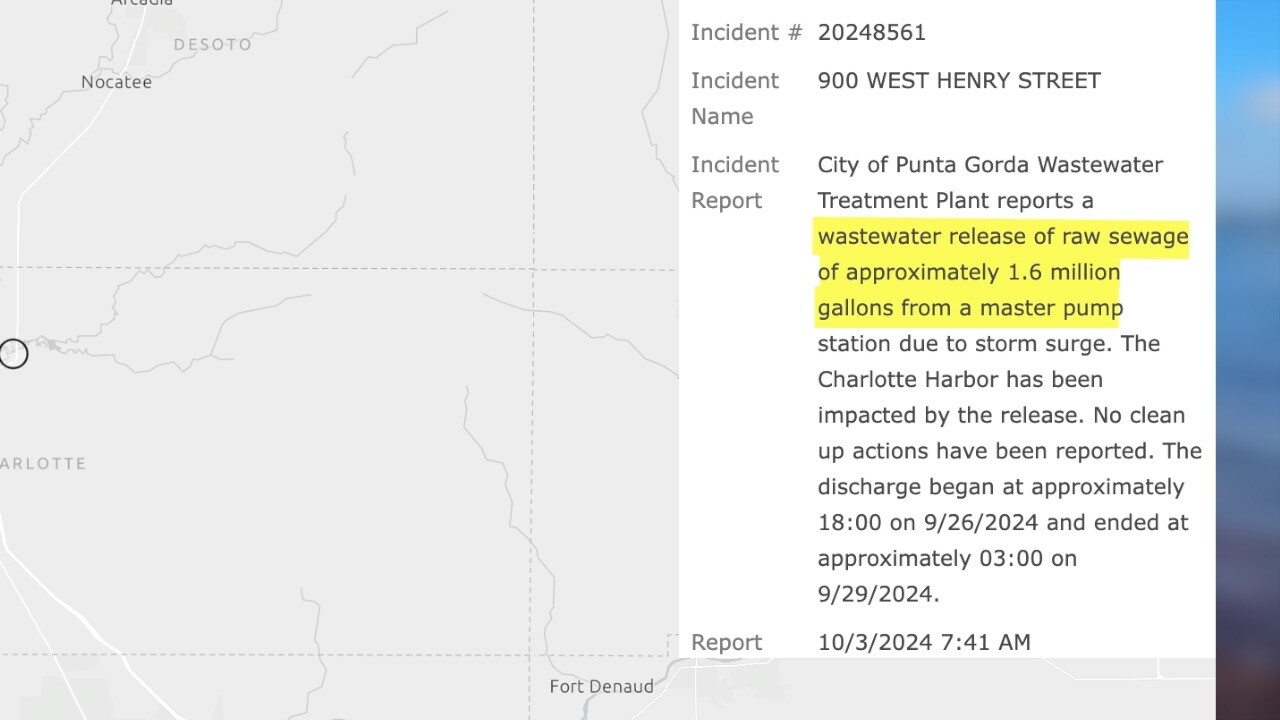PUNTA GORDA, Fla. — After a notice of pollution from the Florida Department of Environmental Protection said the City of Punta Gorda released 1.6 million gallons of “raw sewage” into Charlotte Harbor, the city responded saying in fact it was just stormwater.
Watch FOX 4's Alex Orenczuk report on the City of Punta Gorda's response to an FDEP notice of pollution:
On Thursday, a notice of pollution submitted to FDEP by City of Punta Gorda Utility Supervisor David Brooks stated that the city reported “a wastewater release of raw sewage of approximately 1.6 million gallons from a master pump station due to storm surge” from Sept. 26-29.
The notice continues to say “the Charlotte Harbor has been impacted by the release. No clean up actions have been reported.”

When FOX 4 asked the City of Punta Gorda about the notice, Assistant City Manager Melissa Reichert said that there was no sewage released, it was storm water that inundated the wastewater facility.
“It was neither straight raw sewage nor into the harbor. This was strictly Helene related. It was not an infrastructure failure, not a capacity issue, not a failure of the City. We had 60 pumping stations and 1293 manholes under water from storm surge. The master pumping station on Henry Street was pumping full capacity for days. No failure. The amount of water inundating the system simply overcame what it can handle. The overflow was very dilute, primarily harbor and rainwater, not "raw sewage" as would be pumped on a normal day. The storm surge in the harbor impacted us. The system is not designed nor allowed to pump stormwater. It is a sanitary sewer system, not a combined/stormwater sewer system."
Reichert explained that the form used to report pollution through FDEP does not give the option to report stormwater, so Brooks chose raw sewage. Additionally, the system requires the submitter to select the nearest body of water that could be impacted.
“FDEP is aware that this is storm surge inundation,” said Reichert.
Still, experts say the unprecedented storm surge from Hurricane Helene will likely have adverse impacts on the quality of the water in Charlotte Harbor.

“Nutrient pollution and bacteria pollution can have negative effects on our waterway health and the wildlife that depend on those waterways,” said Nicole Iadevaia, Director of Research & Restoration at the Coastal & Heartland National Estuary Partnership. “An overabundance of nutrients can cause algae blooms, which can have a cascading effect on the ecosystem. It can shade out the existing vegetation which can affect the wildlife.”

Iadevaia said it's common to have pollution notices after large storms, as many pollutants from the land wash into the waterways. She said the more often these storm events happen, the harder it is for aquatic ecosystems to bounce back.
“These ecosystems are built to endure storm events, however, we have seen that these systems may be a little less resilient than they were in the past due to that nutrient and bacteria pollution. It’s not just one cause or one event, over time we can see that when these systems start to degrade they are less resilient when these storms do hit.”
One example Iadevaia gave was the disappearance of seagrass in Charlotte Harbor after Hurricane Irma in 2018.
“We started to see seagrasses start to decline after Hurricane Irma. They took a really big hit, there was an overabundance of nutrients in the waterways, there were a lot of macro algae blooms that shaded out the seagrass and we still haven't recovered from that.”
Iadevaia said investing in infrastructure that can help stop pollutants from entering the waterways after large storms is key to the long term survival of a healthy Charlotte Harbor.
“It's much easier to clean up nutrients and bacteria pollution at the source, rather than when it's already in the water,” said Iadevaia. “So working to build resilient infrastructure, working to upgrade our wastewater treatment systems, getting more people hooked up to advanced wastewater treatment rather than septic, that's really important because all of those things contribute to nutrient pollution and then that flows downstream and degrades the estuaries.”
For more information on water quality, and CHNEP programs monitoring the greater Charlotte Harbor estuarine system, CLICK HERE.



